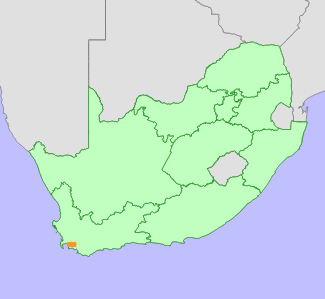|
Scientific Name | Glischrocolla formosa (Thunb.) R.Dahlgren |
Higher Classification | Dicotyledons |
Family | PENAEACEAE |
Synonyms | Penaea formosa Thunb. |
National Status |
Status and Criteria | Critically Endangered C2a(i,ii); D |
Assessment Date | 2011/06/18 |
Assessor(s) | A. Johns, D. Raimondo, C. Paterson-Jones & N.A. Helme |
Justification | Known from only two subpopulations, this species has experienced a 95% decline at one of its subpopulations due to too frequent and incorrect season burns over the past 20 years. Only one mature individual remains in this subpopulation. The second subpopulation has also been subjected to too frequent fires, but due to its inaccessibility the current number of individuals is unknown. Prior to a 2009 burn, fewer than 50 individuals remained in this subpopulation. The total population is therefore less than 50 mature individuals and decline due to frequent fires is ongoing. It is therefore listed as Critically Endangered under criteria C and D. |
Distribution |
Endemism | South African endemic |
Provincial distribution | Western Cape |
Range | This species occurs in the Hottentots Holland Mountains. |
Habitat and Ecology |
Major system | Terrestrial |
Major habitats | Kogelberg Sandstone Fynbos |
Description | Plants grow in damp, southeast-facing cliffs and ledges, 1 200-1 500 m. |
Threats |
| This slow-growing, fire sensitive habitat specialist is confined to high altitude seeps where it can escape from fires. However, increasing fire intensity and frequency has penetrated this species' habitat, and a 95% decline has been recorded in two known subpopulations in the past 20 years. |
Population |
Two small subpopulations are known. After a recent fire, only one plant remained in one of these subpopulations, the result of a 95% decline in number of mature individuals. The other subpopulation is too inaccessible to do a population count, but it is estimated that in total less than 50 mature individuals remain, and it is not possible to estimate a population reduction for this subpopulation.
|
Population trend | Decreasing |
Notes |
| A palaeoendemic, slow-growing, ant-dispersed reseeder. |
Assessment History |
Taxon assessed |
Status and Criteria |
Citation/Red List version | | Glischrocolla formosa (Thunb.) R.Dahlgren | VU D1 | Raimondo et al. (2009) | | Glischrocolla formosa (Thunb.) R.Dahlgren | Vulnerable | Hilton-Taylor (1996) | | Glischrocolla formosa (Thunb.) R.Dahlgren | Vulnerable | Hall et al. (1980) | |
Bibliography |
Goldblatt, P. and Manning, J.C. 2000. Cape Plants: A conspectus of the Cape Flora of South Africa. Strelitzia 9. National Botanical Institute, Cape Town.
Hall, A.V., De Winter, M., De Winter, B. and Van Oosterhout, S.A.M. 1980. Threatened plants of southern Africa. South African National Scienctific Programmes Report 45. CSIR, Pretoria.
Hilton-Taylor, C. 1996. Red data list of southern African plants. Strelitzia 4. South African National Botanical Institute, Pretoria.
Raimondo, D., von Staden, L., Foden, W., Victor, J.E., Helme, N.A., Turner, R.C., Kamundi, D.A. and Manyama, P.A. 2009. Red List of South African Plants. Strelitzia 25. South African National Biodiversity Institute, Pretoria.
|
Citation |
| Johns, A., Raimondo, D., Paterson-Jones, C. & Helme, N.A. 2011. Glischrocolla formosa (Thunb.) R.Dahlgren. National Assessment: Red List of South African Plants version 2024.1. Accessed on 2025/11/19 |
 Comment on this assessment
Comment on this assessment


